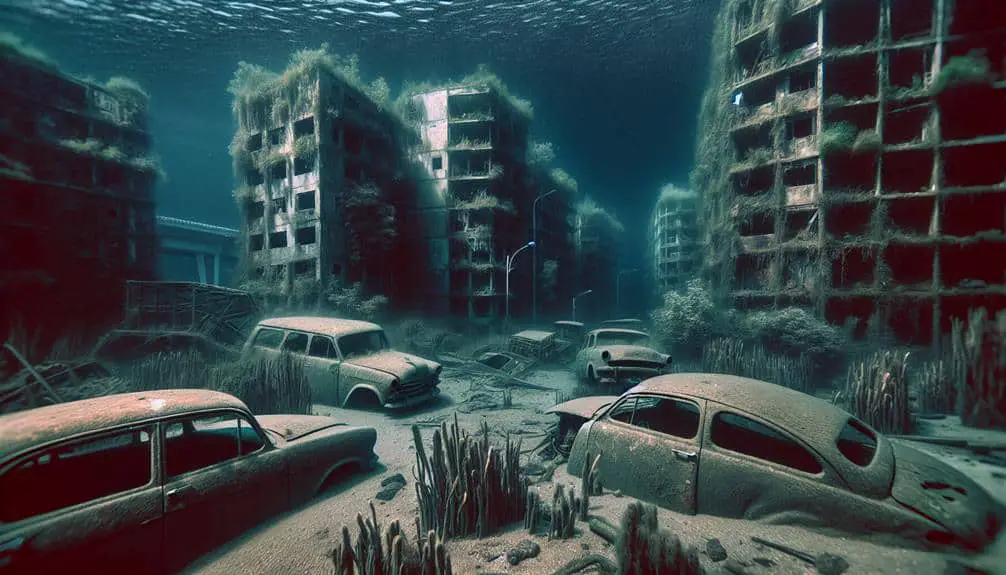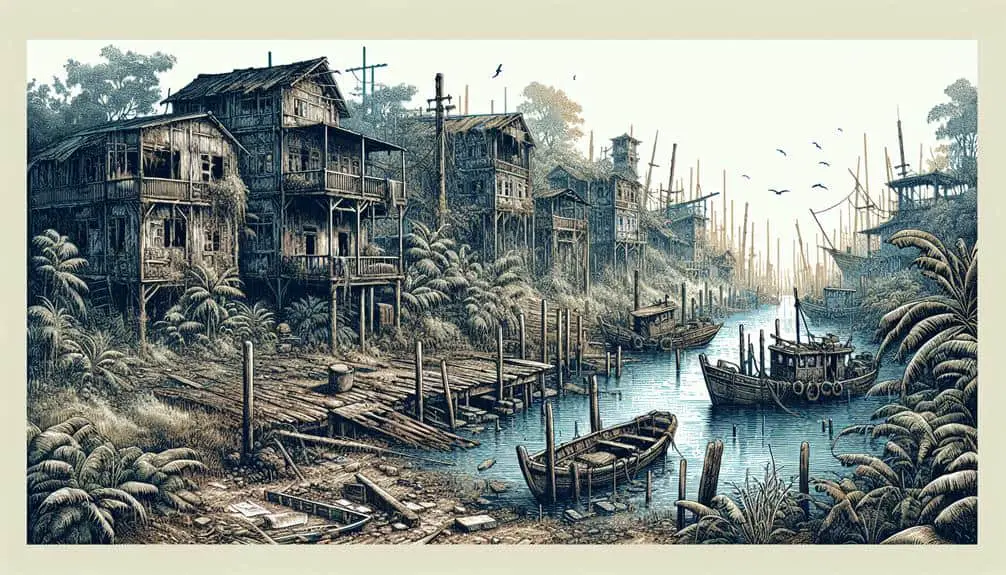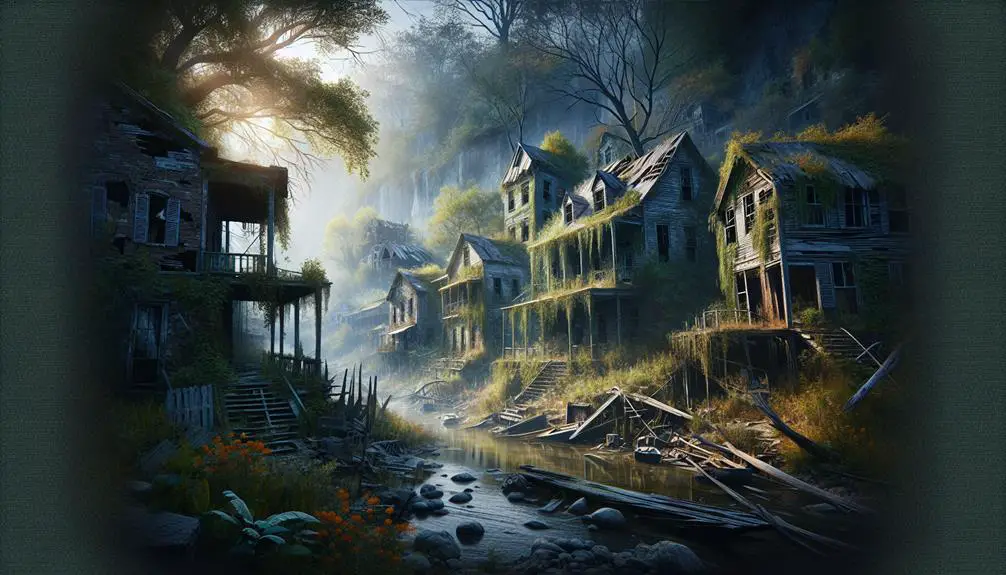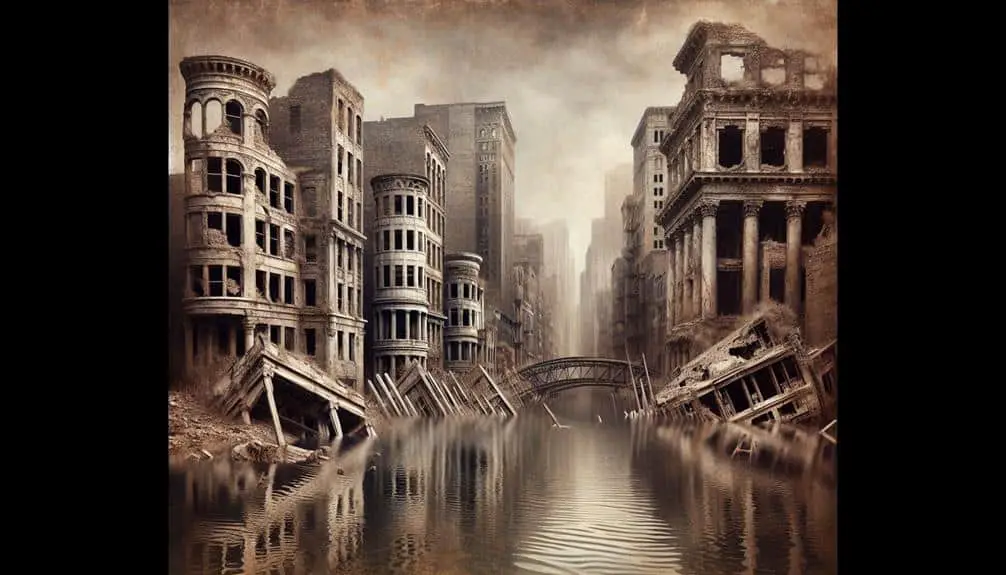Uncover the secrets of submerged US riverfront ghost towns created by historic floods. Scholars explore riverbeds to reveal lost civilizations through underwater archaeology. Floodwaters force communities to abandon homes, leaving eerie abandoned structures whispering tales of the past. Preservation faces challenges in underwater environments, needing community support for conservation efforts. Discover haunting stories and local legends of ghostly apparitions among sunken structures. These submerged towns offer valuable insights into past cultural landscapes. Dig deeper into the enigmatic history and secrets hidden beneath murky waters to unravel the mysteries of lost civilizations and abandoned structures.
Key Points
- Submerged towns formed from historic floods along the Mississippi River.
- Underwater archaeology reveals lost civilizations and artifacts.
- River flooding displaces communities, leaving abandoned structures.
- Preservation efforts face challenges from rapid deterioration and water damage.
- Local legends tell eerie stories of ghostly apparitions in sunken ghost towns.
Historic Origins of Submerged Towns
During the early 20th century, a series of historic floods along the Mississippi River led to the creation of several submerged towns in the region. The remnants of these lost civilizations have become fascinating subjects for underwater archaeology. Scholars and researchers have explored the depths of the riverbeds to uncover the secrets of these submerged towns, shedding light on a bygone era.
The field of underwater archaeology plays an important role in piecing together the history of these submerged towns. By carefully studying artifacts and structures preserved underwater, experts can investigate the daily lives and activities of the inhabitants who once thrived in these now-submerged communities.
Lost civilizations hidden beneath the waters offer a glimpse into the past, providing valuable insights into the cultural, social, and economic landscapes of the time. Through meticulous research and exploration, these underwater archaeological sites contribute to our understanding of the rich history of the Mississippi River region.
Impact of River Flooding
The recurring cycle of river flooding significantly alters the landscape and contributes to the creation of submerged towns along the Mississippi River. When rivers overflow their banks, they can displace entire communities, forcing residents to abandon their homes and livelihoods. This community displacement is a direct result of the environmental consequences of river flooding.
The impact of river flooding goes beyond just the physical displacement of residents. It also leads to significant environmental consequences, such as erosion of riverbanks, contamination of water sources, and destruction of ecosystems. The force of the floodwaters can weaken structures, leading to the eventual collapse of buildings and infrastructure within these towns.
As river flooding continues to shape the landscape, it serves as a reminder of the power of nature and the importance of preparedness. Understanding the impact of river flooding on submerged towns can help communities develop strategies to mitigate future risks and protect both their heritage and their people.
Abandoned Buildings and Structures
Amidst the aftermath of river flooding, the landscape is dotted with abandoned buildings and structures that stand as eerie remnants of the once vibrant communities that inhabited these now submerged towns. These abandoned structures hold architectural secrets waiting to be uncovered by those brave enough to venture into the world of urban exploration. The peeling paint, crumbling facades, and overgrown vegetation provide a hauntingly beautiful backdrop for those intrigued by the stories these buildings have to tell.
Urban exploration enthusiasts find themselves drawn to these abandoned structures, seeking to capture the essence of a bygone era frozen in time. The decaying walls and rusted beams whisper tales of the past, inviting visitors to explore the mysteries hidden within these forsaken buildings. From forgotten homes to deserted storefronts, each structure offers a unique glimpse into the lives of the people who once called these places home.
As you navigate through these abandoned buildings, remember to tread lightly, for every creaking floorboard and peeling wallpaper conceals a piece of history waiting to be discovered.
Preservation Efforts and Challenges
Preserving the integrity of these abandoned structures in submerged riverfront ghost towns poses a significant challenge requiring meticulous planning and dedicated resources. Preservation challenges arise due to the underwater environment causing rapid deterioration of the buildings and structures. The community involvement plays an important role in these preservation efforts, as local support can provide the necessary manpower, funding, and expertise needed to maintain these historical sites.
One of the primary preservation challenges is the constant threat of erosion and water damage to the submerged structures. Without proper maintenance and protection, these buildings are at risk of collapsing or being lost to the waters forever. Additionally, the unique underwater conditions make it difficult to access and work on these sites, further complicating preservation efforts.
Community involvement is vital in overcoming these challenges. Local groups can organize clean-up efforts, fundraising events, and awareness campaigns to garner support for the preservation of these ghost towns. By working together, communities can guarantee that these submerged riverfront sites are protected for future generations to explore and appreciate.
Haunting Stories and Local Legends
Exploring through the submerged ruins of riverfront ghost towns reveals a tapestry of eerie stories and local legends that have intertwined themselves into the fabric of these underwater landscapes. Local folklore surrounding these abandoned settlements often speaks of ghostly apparitions, paranormal activity, and supernatural occurrences that are said to haunt the waters. Witnesses have reported eerie sightings of shadowy figures moving among the sunken structures, adding to the mystique of these underwater mysteries.
Legends passed down through generations tell of tragic events that befell the towns, leaving behind a lingering energy that some believe still resonates beneath the surface. Reports of inexplicable sounds, lights flickering in the depths, and unexplained disturbances have fueled the fascination with these submerged ghost towns.
Whether one believes in the supernatural or not, the allure of these submerged riverfront settlements and the haunting stories that accompany them continue to captivate the imagination of those drawn to the mysterious and unknown.
Frequently Asked Questions
How Do Underwater Ghost Towns Affect the Local Ecosystem?
You might think underwater ghost towns wreck ecosystems, but they create unique habitats for marine life, boosting biodiversity. Preserving these sites can enhance local ecosystems, balancing nature's intricate web of interconnected species.
Are There Any Plans to Restore or Rebuild Any of the Submerged Towns?
If you're curious about potential restoration plans for the submerged towns, consider the community impact. Efforts to rebuild could revitalize local economies, preserve history, and provide opportunities for tourism, balancing environmental concerns with historical significance.
What Is the Significance of These Ghost Towns in the Local Cultural Heritage?
The significance of these ghost towns in local cultural heritage lies in their link to the past, serving as poignant reminders of history. Cultural preservation efforts aim to safeguard and honor the historical significance of these submerged landmarks.
Have Any Artifacts or Treasures Been Found in the Submerged Buildings?
When exploring submerged buildings, you may discover underwater artifacts that shed light on the past. Unearthed treasures not only offer historical preservation but also raise awareness about the environmental impact of underwater archaeology.
How Have Modern Technologies Like Sonar and Drones Been Used to Explore These Underwater Towns?
To explore underwater towns, modern technologies like sonar mapping and drones play essential roles. Sonar mapping provides detailed layouts of submerged structures, while drone footage captures high-resolution images, aiding in the examination and preservation of these historical sites.



